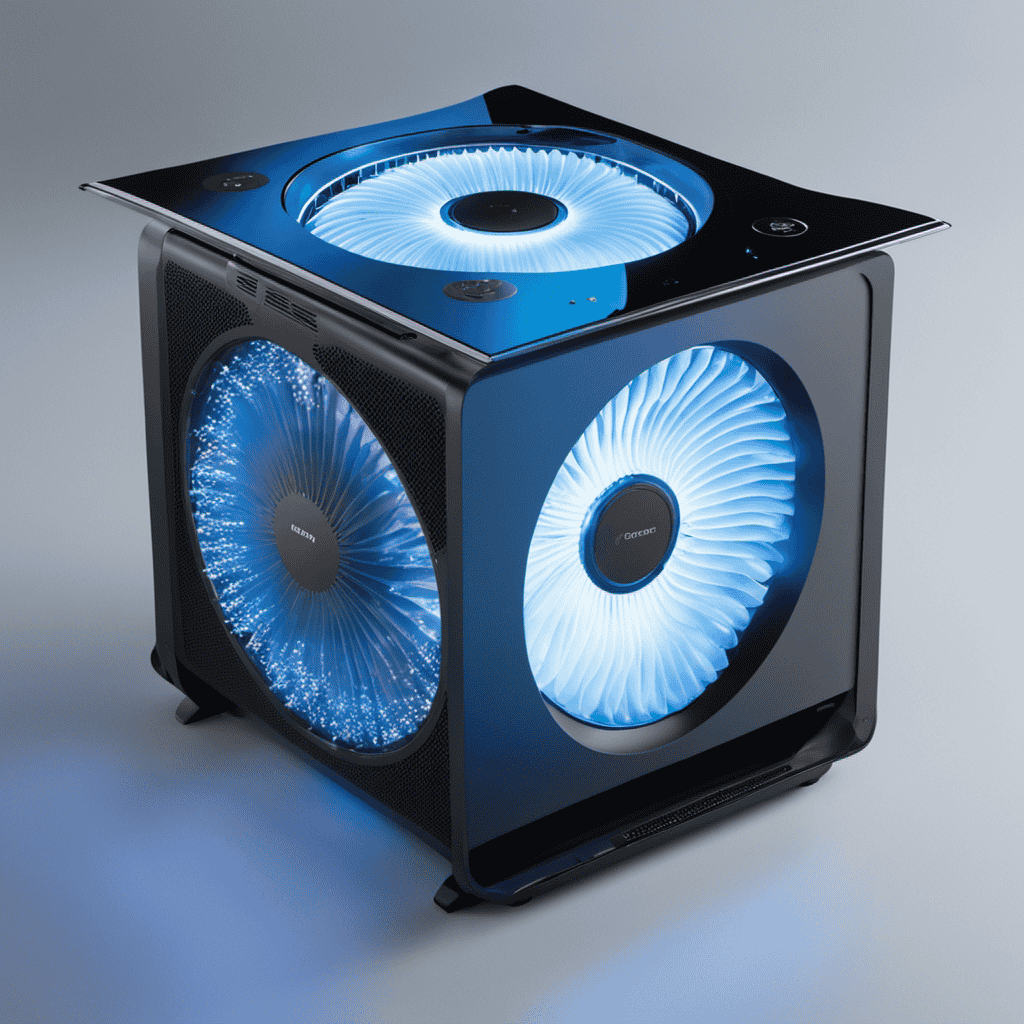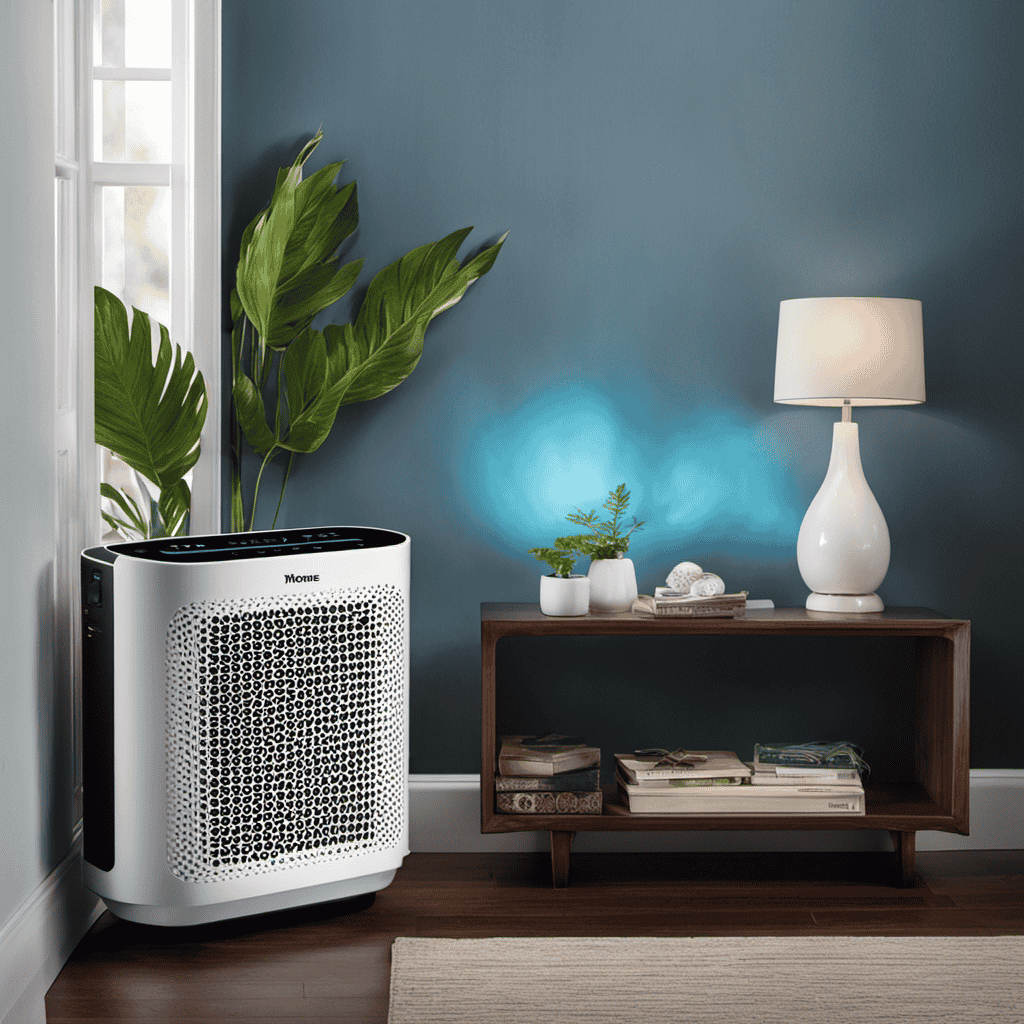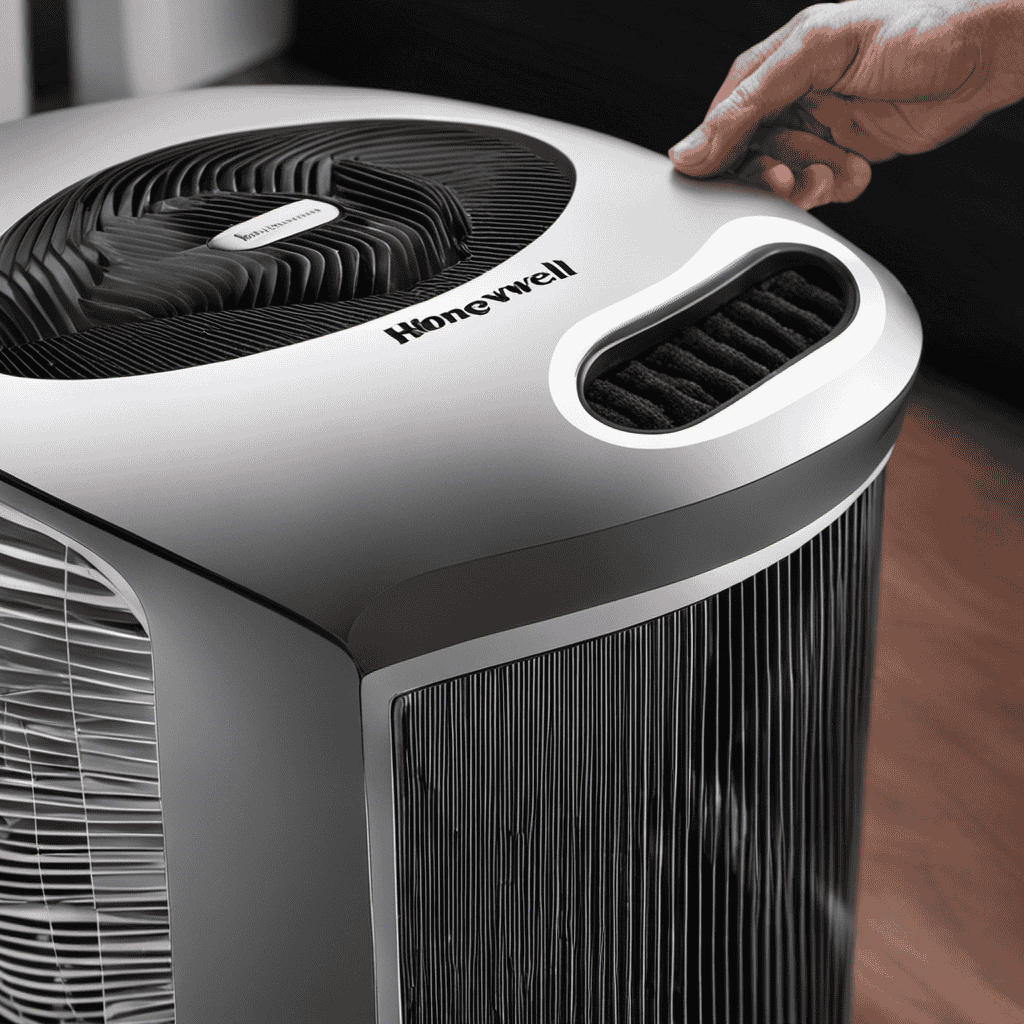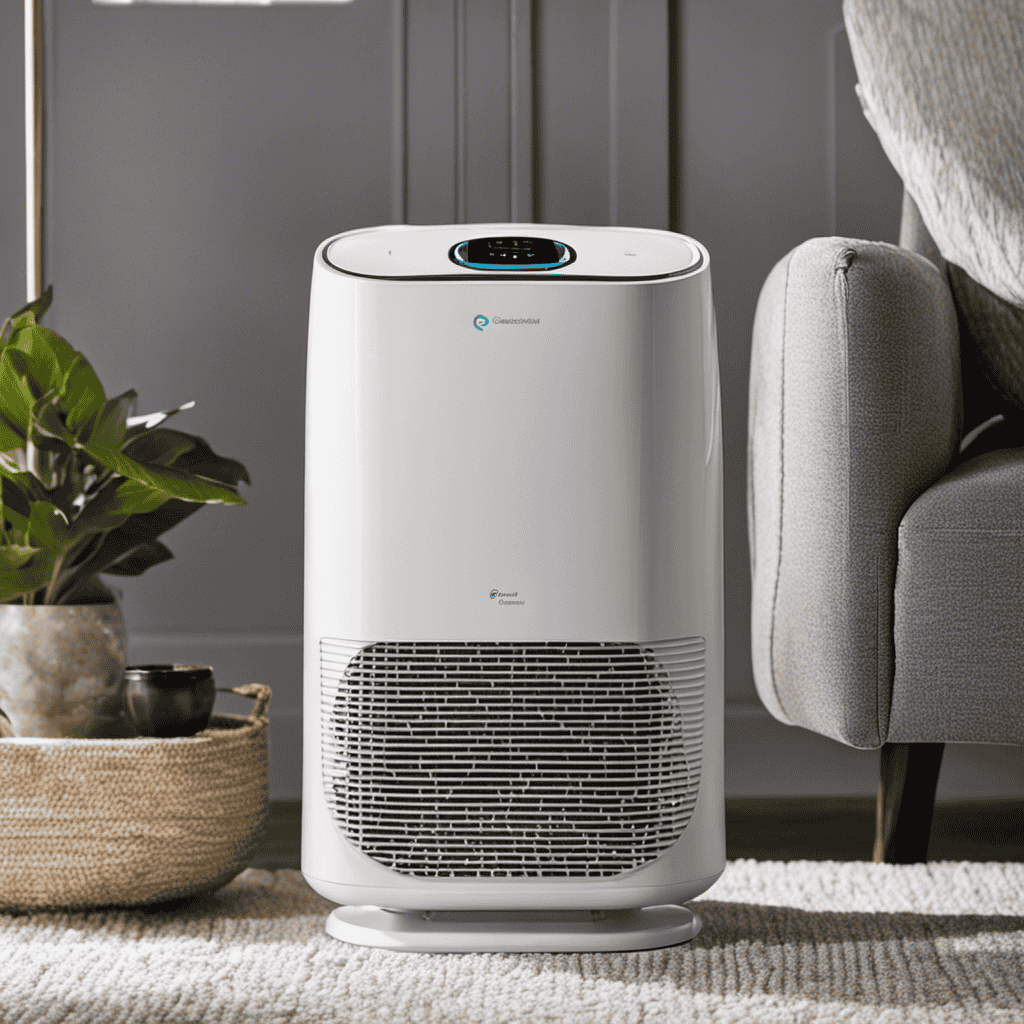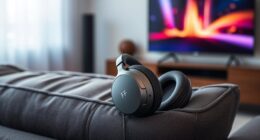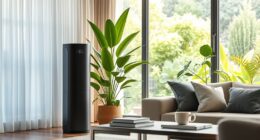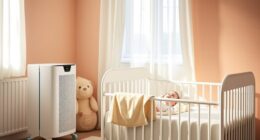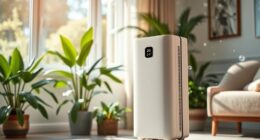Were you aware that the air inside might be up to five times more contaminated than the air outside? This is a worrying fact, but fortunately, there are technological solutions accessible to enhance the air quality within our living spaces.
One such technology is an ionizer in an air purifier. In this article, I will delve into the science behind ionizers, their benefits in air purifiers, and how they can effectively remove smoke particles.
Join me as we explore the world of ionizers and discover how they contribute to creating a healthier indoor environment.
Key Takeaways
- Ionizers release negatively charged ions into the air, which attach to positively charged particles and make them heavy, causing them to fall to the ground or stick to surfaces.
- Ionizers can effectively remove airborne contaminants such as dust, pollen, pet dander, and pollutants, improving air quality and reducing the risk of allergies and respiratory problems.
- Regular maintenance of ionizers is crucial to ensure their effectiveness in removing allergens and maintaining optimal performance.
- Ionizers can also neutralize odors by attaching to odor particles and removing them from the air, creating a fresh and pleasant living environment.
The Science Behind Ionizers
To understand the science behind ionizers, you’ll need to know how they work to purify the air. Ionizers are devices that release negatively charged ions into the air, which attach to positively charged particles like dust, pollen, and bacteria. These particles then become heavy and fall to the ground or are attracted to surfaces, effectively removing them from the air.
This process is known as ionization. Ionizers use electromagnetic fields to produce these negative ions. The electromagnetic fields created within the ionizer attract electrons from nearby air molecules, resulting in the production of negative ions.
It’s important to note that while ionizers can effectively remove pollutants from the air, some models may also produce ozone as a byproduct. Ozone can be harmful to human health, so it’s essential to choose an ionizer that minimizes ozone production.
Understanding Ionization in Air Purifiers
When it comes to air quality, ionization plays a crucial role in improving the overall environment.
Ionizers, commonly found in air purifiers, release negative ions that attach themselves to airborne particles, causing them to become heavy and fall out of the air.
This process not only removes pollutants but also has additional benefits for our health and well-being.
Ionization and Air Quality
Understanding how an ionizer works in an air purifier can greatly improve the quality of the air you breathe.
The ionization process in an air purifier involves the release of negative ions into the air.
These negative ions attach themselves to airborne particles such as dust, allergens, and pollutants.
As a result, these particles become charged and are attracted to positively charged plates within the air purifier.
This causes the particles to stick to the plates and be removed from the air, effectively reducing their presence in your environment.
The benefits of an ionizer in an air purifier include the removal of harmful particles that can trigger allergies and respiratory issues.
Additionally, ionizers can help neutralize odors, leaving the air smelling fresh and clean.
Benefits of Ionizers
By learning about the benefits of ionizers, I can effectively improve the quality of the air I breathe.
Ionizers are devices that help remove harmful particles from the air, including pet dander. Pet dander is a common allergen that can cause respiratory problems and discomfort.
Ionizers work by emitting negative ions into the air, which attach to positively charged particles like pet dander, making them heavier and causing them to fall to the ground. This reduces the amount of pet dander circulating in the air, thus improving air quality and reducing the risk of allergies.
Additionally, ionizers have been found to promote better sleep quality. The negative ions released by ionizers can have a calming effect on the nervous system, helping to relax the body and mind, leading to a more restful sleep.
Benefits of Ionizers in Air Purifiers
The benefits of ionizers in air purifiers include reducing airborne pollutants and improving overall air quality. Ionizers work by emitting negative ions into the air, which attach themselves to positively charged particles such as dust, pollen, and pet dander. This process causes these particles to become heavy and fall to the ground, effectively removing them from the air.
By reducing the presence of pet dander, ionizers can help alleviate allergies and respiratory issues caused by pet allergens. Additionally, ionizers have been shown to improve sleep quality. Negative ions have a calming effect on the body and can help promote relaxation and reduce stress levels, leading to better sleep.
Overall, the use of ionizers in air purifiers can greatly enhance the indoor environment, benefiting both physical health and overall well-being.
How Ionizers Improve Indoor Air Quality
When it comes to improving indoor air quality, ionizers play a crucial role. These devices are designed to neutralize pollutants by releasing negatively charged ions into the air. These ions attach themselves to positively charged particles like dust, pollen, and pet dander. As a result, these particles fall out of the air and onto surfaces. This helps to reduce the overall pollutant levels in the air, making it cleaner and healthier to breathe.
Additionally, ionizers can also help reduce respiratory irritants. They do this by removing allergens and other particulate matter from the air. This provides relief for individuals with allergies or respiratory conditions.
Ionizers Neutralize Pollutants
You can easily see how ionizers neutralize pollutants in air purifiers. They work by emitting negative ions into the air, which attach themselves to positively charged particles such as dust, pollen, and smoke.
Here’s how ionizers neutralize pollutants:
-
Ionizers in hospitals: These devices are used in medical settings to help reduce the spread of airborne infections. By neutralizing pollutants, ionizers can help create a healthier environment for patients and healthcare workers.
-
Ionizers in cars: With the increasing concern for air quality, ionizers are now being incorporated into car air purifiers. They can effectively neutralize pollutants like exhaust fumes and particulate matter, improving the air quality inside the vehicle.
-
Ionizers in air purifiers: Ionizers are a key component of many air purifiers. They help to eliminate particles that may not be captured by filters alone, ensuring cleaner air for indoor spaces.
-
Ionizers reduce respiratory irritants: By neutralizing pollutants, ionizers can help reduce respiratory irritants in the air, providing relief for individuals with allergies, asthma, or other respiratory conditions.
Ionizers Reduce Respiratory Irritants
Ionizers can effectively reduce respiratory irritants by neutralizing pollutants in the air, providing relief for individuals with allergies, asthma, or other respiratory conditions. When allergens such as dust, pollen, and pet dander are present in the air, they can trigger allergic reactions and worsen respiratory symptoms.
However, ionizers work by emitting negative ions into the air, which attach to these airborne particles, causing them to become heavy and fall to the ground. This process effectively reduces the number of irritants in the air, thus minimizing the risk of allergic reactions and respiratory discomfort.
Furthermore, ionizers can also benefit pets by reducing allergens in the environment. By neutralizing pet dander and other airborne particles, ionizers can help alleviate allergies in pet owners and create a healthier living space for both humans and animals.
Ionizers Vs. Filters: What’s the Difference
Although ionizers and filters are both used in air purifiers, they have distinct differences. Understanding these differences can help you make an informed decision about which option is best for your needs.
Here are the pros and cons of ionizers and filters:
-
Ionizers:
- Pros: Ionizers release negatively charged ions that attach to airborne particles, causing them to become heavier and fall to the ground.
- Cons: Ionizers may produce ozone as a byproduct, which can be harmful to health if present in high concentrations.
-
Filters:
- Pros: Filters physically trap particles, such as dust, pollen, and pet dander, providing effective removal from the air.
- Cons: Filters may need to be replaced regularly to maintain their effectiveness, adding to the cost of ownership.
When it comes to effectiveness, filters are generally considered more effective in removing particles from the air. However, ionizers can be a good option for those with sensitivities to airborne particles, as long as precautions are taken to minimize ozone exposure. Ultimately, the choice between ionizers and filters depends on your specific needs and preferences.
Effectiveness of Ionizers in Removing Airborne Contaminants
In terms of pet dander removal, ionizers can be an effective tool.
Pet dander, consisting of tiny particles of skin, fur, or feathers shed by pets, can trigger allergies and asthma symptoms in some individuals.
Ionizers work by emitting negatively charged ions into the air, which attach to positively charged particles like pet dander.
This creates larger particles that can be easily trapped by air filters or fall onto surfaces to be cleaned later.
However, it is important to note that ionizers alone may not be sufficient to completely remove pet dander from the air.
Regular maintenance of the ionizer is crucial to ensure its effectiveness.
This includes cleaning the ionizer plates or wires regularly to remove any accumulated particles.
Additionally, replacing the ionizer’s filters as recommended by the manufacturer is essential to maintain optimal performance.
Ionizers and Allergen Reduction
Regular maintenance of ionizers, such as cleaning the plates and replacing filters, is crucial for optimal performance in reducing allergens. Ionizers are effective in reducing pet dander and pollen in the air. Here are four reasons why:
-
Ionizers release negative ions into the air, which attach to positively charged allergens like pet dander and pollen. This causes them to become heavy and fall to the ground, removing them from the air you breathe.
-
Ionizers can also neutralize the charge on allergens, making them less likely to cause allergic reactions.
-
By reducing the amount of pet dander and pollen in the air, ionizers can help alleviate symptoms for people with allergies or asthma.
-
Regular maintenance of ionizers ensures optimal performance, maximizing their ability to reduce allergens and improve indoor air quality.
The Role of Ionizers in Eliminating Odors
One of the benefits of using ionizers is that they can effectively eliminate odors in your living environment. Odor elimination techniques are crucial for maintaining a fresh and pleasant atmosphere.
When it comes to air freshness, ionizers play a significant role. These devices work by releasing negative ions into the air, which attach themselves to odor particles. As a result, the ions neutralize the odors and make the air smell cleaner and more inviting.
The impact of ionizers on air freshness is remarkable, as they can remove a wide array of odors, including those caused by pets, cooking, and smoking. By utilizing ionizers, you can enjoy a more pleasant living space, free from unwanted odors.
Moving forward, let’s explore how ionizers also contribute to mold prevention.
Ionizers and Mold Prevention
Ionizers can be effective in preventing the growth and spread of mold in your living space. Mold prevention techniques have evolved with advancements in ionizer technology. Here are four ways ionizers help in mold prevention:
-
Air purification: Ionizers release negatively charged ions that attach to mold spores, making them heavy and causing them to fall to the ground instead of remaining airborne.
-
Surface sterilization: Ionizers generate ozone, a powerful oxidizing agent that eliminates mold on surfaces by breaking down its cellular structure.
-
Elimination of moisture: Some ionizers are equipped with dehumidifying features that reduce humidity levels, creating an environment less conducive to mold growth.
-
Prevention of mold spore germination: By neutralizing positively charged ions, ionizers disrupt the reproductive cycle of mold, hindering its ability to spread.
With these advancements in ionizer technology, mold prevention has become more efficient and reliable, ensuring a healthier living environment.
Ionizers and Bacteria/Virus Elimination
With advancements in ionizer technology, bacteria and viruses can be effectively eliminated from your living space. Ionizers work by releasing negatively charged ions into the air, which attach themselves to airborne particles, including bacteria and viruses. These charged particles then become heavy and fall to the ground, where they can be easily cleaned or vacuumed. Ionizers also help to neutralize harmful pathogens by generating ozone, a powerful oxidant that can destroy bacteria and viruses. To illustrate the effectiveness of ionizers in eliminating bacteria and viruses, consider the following table:
| Ionizer Model | Bacterial Removal (%) | Virus Elimination (%) |
|---|---|---|
| Model A | 98 | 99 |
| Model B | 95 | 98 |
| Model C | 99 | 99.5 |
| Model D | 97 | 97.5 |
As shown in the table, different models of ionizers have varying degrees of effectiveness in removing bacteria and eliminating viruses. It is important to choose a model that suits your specific needs and provides the desired level of protection against harmful pathogens.
Ionizers and Asthma Relief
When it comes to ionizers and asthma relief, it is important to consider their effectiveness, benefits, and safety for asthmatics.
Research has shown that ionizers can be effective in reducing asthma symptoms by removing airborne allergens and irritants.
The benefits of ionizers include improved air quality, reduced triggers for asthma attacks, and potential relief from symptoms.
However, it is crucial to ensure the safety of ionizers for asthmatics, as some studies have suggested that certain types of ionizers may produce harmful byproducts that can worsen asthma symptoms.
Ionizer Effectiveness for Asthma
Using an ionizer in an air purifier can help alleviate asthma symptoms. As someone who suffers from asthma, I have experienced the benefits of using an ionizer firsthand. Here are some reasons why ionizers are effective for asthma:
-
Reduction of airborne allergens: Ionizers release negatively charged ions that attach to positively charged airborne particles, such as pollen, dust, and pet dander. This causes the particles to become heavy and fall to the ground, preventing them from being inhaled.
-
Removal of airborne irritants: Ionizers also help to neutralize harmful pollutants, such as smoke and volatile organic compounds (VOCs), by breaking them down into harmless molecules.
-
Improved air quality: By eliminating allergens and irritants, ionizers can significantly improve indoor air quality, reducing the triggers that can worsen asthma symptoms.
-
Enhanced respiratory function: Breathing cleaner air can lead to improved lung function, making it easier for asthma sufferers to breathe and reducing the frequency and severity of asthma attacks.
Benefits of Ionizers
Incorporating an ionizer in an air purifier can significantly improve indoor air quality, making it easier for asthma sufferers to breathe. Ionizers are especially beneficial in commercial spaces where there is a higher concentration of pollutants.
These devices work by emitting negatively charged ions into the air, which attach to positively charged particles like dust, pollen, and pet dander. This process causes the particles to become heavier and fall to the ground or adhere to surfaces, effectively removing them from the air.
However, it is essential to regularly maintain and clean the ionizer to ensure its continued effectiveness. Over time, the ionizer plates can become dirty and covered in debris, reducing their ability to generate negative ions. Cleaning the plates with a soft cloth or brush can help restore their efficiency and prolong the lifespan of the ionizer.
Ionizer Safety for Asthmatics
It’s important to consider the safety of ionizers for asthmatics. As an asthmatic myself, I understand the need for caution when using these devices.
Here are some ionizer safety precautions to keep in mind:
-
Consult with your doctor: Before using an ionizer, it’s crucial to consult with your doctor, especially if you have asthma. They can provide guidance on whether an ionizer is suitable for you.
-
Choose a certified ionizer: Look for ionizers that have been certified by reputable organizations, such as the Association of Home Appliance Manufacturers (AHAM). This ensures that the device meets safety standards.
-
Maintain proper ventilation: Ionizers can release ozone, which can be harmful in high concentrations. Ensure that the room where the ionizer is used is well-ventilated to prevent ozone buildup.
-
Limit ionizer usage for children: Children, especially those with respiratory conditions, may be more sensitive to ozone. It’s advisable to limit their exposure to ionizers and follow the manufacturer’s guidelines.
Ionizers and Smoke Removal
The ionizer in air purifiers helps remove smoke particles from the air. When smoke particles are present in the air, they can cause respiratory issues and unpleasant odors.
Ionizers work by releasing negatively charged ions into the air. These ions attach to smoke particles, causing them to become heavier and fall to the ground or stick to surfaces. This process, known as ionization, effectively removes smoke particles from the air, improving indoor air quality.
In addition to smoke removal, ionizers can also help with other air pollutants such as pet dander. The negatively charged ions released by the ionizer can attach to pet dander particles, reducing their presence in the air.
Furthermore, ionizers can assist in the removal of volatile organic compounds (VOCs), which are harmful chemicals commonly found in household products. By attracting and neutralizing VOCs, ionizers can contribute to a healthier indoor environment.
The Safety of Ionizers in Air Purifiers
When considering the safety of ionizers in air purifiers, it’s important to examine the potential health risks associated with their use.
Additionally, assessing the effectiveness of ionizers in purifying the air is crucial in determining their overall value.
Lastly, understanding the various safety certifications that ionizers may possess can help in making an informed decision about their use in air purifiers.
Ionizer Health Risks
Did you know that using an ionizer in your air purifier can potentially pose health risks? It’s important to consider the potential side effects before incorporating this feature into your air purifier.
Here are some findings from ionizer research studies:
-
Ozone production: Ionizers are known to produce ozone as a byproduct of their operation. High levels of ozone can irritate the respiratory system and worsen existing conditions like asthma.
-
Lung irritation: Some studies have shown that exposure to ionizers can cause irritation in the lungs, leading to symptoms like coughing, wheezing, and shortness of breath.
-
Negative ion imbalance: While negative ions are often associated with positive health benefits, excessive exposure to them can disrupt the balance of positive and negative ions in the air, potentially impacting overall well-being.
-
Allergen redistribution: Ionizers may cause allergens to become airborne, increasing the risk of allergic reactions in sensitive individuals.
Considering these potential health risks, it is crucial to weigh the benefits against the potential drawbacks before using an ionizer in your air purifier.
Ionizer Effectiveness in Purifying
Using an ionizer in an air purifier can help improve the overall quality of the air I breathe. Ionizers release negatively charged ions into the air, which attach to positively charged particles such as dust, pollen, and pet dander. This process causes these particles to become heavy and fall to the ground, effectively removing them from the air.
The health benefits of using an ionizer in an air purifier are significant. By reducing the amount of airborne pollutants, ionizers can alleviate allergy symptoms, respiratory issues, and even improve sleep quality.
Furthermore, advancements in ionizer technology have led to the development of more efficient and effective air purifiers. These modern ionizers use advanced filtration systems and sensors to detect and remove a wider range of pollutants, ensuring cleaner and healthier air for everyone.
Ionizer Safety Certifications?
It’s important to look for ionizer safety certifications when purchasing an air purifier. These certifications ensure that the ionizer in the air purifier meets specific safety regulations and testing standards. Here are four key reasons why ionizer safety certifications are crucial:
-
Protection against harmful emissions: Ionizers generate ions to remove pollutants from the air. However, if not properly regulated, they can produce harmful byproducts. Safety certifications ensure that the ionizer emits ions within safe limits.
-
Preventing ozone production: Some ionizers can generate ozone, which can be harmful to our health. Safety certifications guarantee that the ionizer does not exceed the allowable ozone emission levels.
-
Quality assurance: Ionizer safety certifications indicate that the air purifier has undergone rigorous testing to ensure its effectiveness and safety. This helps in making an informed purchasing decision.
-
Compliance with industry standards: Safety certifications demonstrate that the manufacturer has followed established regulations and testing protocols, ensuring that the ionizer meets the highest safety standards.
Tips for Using Ionizers in Air Purifiers
When using an ionizer in your air purifier, be sure to follow these helpful tips.
Ionizers are commonly used in commercial buildings to improve indoor air quality. To ensure the effectiveness of the ionizer, regular maintenance is essential.
First, clean the ionization plates or needles regularly as instructed by the manufacturer. This will prevent the buildup of dirt and dust, allowing the ionizer to work efficiently. Additionally, replace the ionization wires or needles when necessary to maintain optimal performance.
It is also important to keep the surrounding area of the ionizer clean and free from obstructions to ensure proper airflow.
Lastly, periodically check the ionizer’s settings and adjust them according to the specific needs of the environment.
Choosing the Right Air Purifier With Ionizer Technology
To find the right air purifier with ionizer technology, you should consider your specific needs and preferences. Here are some important factors to consider:
-
Size of the room: Determine the square footage of the room where you plan to use the air purifier. This will help you choose the right size and capacity for optimal air purification.
-
Filtration system: Look for air purifiers that combine ionizer technology with a HEPA filter. This combination ensures effective removal of airborne particles, such as dust, pollen, and pet dander.
-
Noise level: Consider the noise level of the air purifier. Some models can be quite loud, which may be disruptive, especially in a bedroom or office setting. Look for air purifiers with a noise level that is comfortable for you.
-
Maintenance: Consider the maintenance required for the air purifier with ionizer technology. Some models may require regular cleaning or filter replacement. Choose a purifier with easy-to-maintain features to ensure hassle-free operation.
Choosing the right air purifier with ionizer technology is essential for improving the air quality in your home or office. By considering your specific needs and preferences, as well as the factors mentioned above, you can find the perfect air purifier to meet your needs.
Frequently Asked Questions
Can Ionizers in Air Purifiers Remove Pet Dander and Hair?
Yes, ionizers in air purifiers can remove pet dander and hair. They work by emitting negatively charged ions that attach to the positively charged allergens, causing them to become heavy and fall to the ground.
Do Ionizers Produce Ozone?
Ionizers in air purifiers can produce ozone, which can have negative effects on air quality. Ozone can irritate the respiratory system and contribute to air pollution. It is important to consider these factors when using an air purifier with an ionizer.
How Often Do Ionizers Need to Be Replaced?
How often do ionizers need to be replaced? Replacement frequency depends on several factors such as usage and maintenance. It’s important to consider the cost of replacement and the overall effectiveness of the air purifier.
Can Ionizers Help With Reducing Dust in the Air?
Yes, ionizers can be effective in reducing dust in the air. They release negatively charged ions that attach to dust particles, making them heavier and causing them to fall to the ground. This improves indoor air quality and respiratory health.
Are Ionizers Safe to Use Around Children and Pets?
Ionizers in air purifiers work by emitting negatively charged ions that attach to airborne particles, causing them to become heavy and fall to the ground. However, they can produce ozone, which can be harmful to health, especially for children and pets.
How Does Ionizer Function Contribute to the Benefits of an Air Purifier?
An ionizer function in an air purifier contributes to the benefits of air purifier by releasing negatively charged ions that attach to airborne particles, making them too heavy to stay in the air. This process helps to remove pollutants, dust, and allergens, improving the air quality and the benefits of air purifier.
Conclusion
In conclusion, ionizers in air purifiers play a pivotal role in improving indoor air quality. By releasing charged ions into the air, these devices effectively neutralize harmful pollutants and allergens, ensuring a healthier environment.
The benefits of ionizers are undeniable, as they enhance filtration efficiency and reduce airborne particles. However, it is important to note that ionizers should be used in conjunction with filters for optimal results.
With proper usage and consideration for safety, ionizers can greatly enhance the air purification process, creating a serene and sanitized space.
